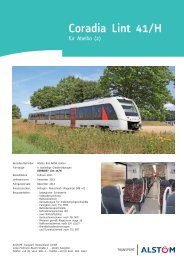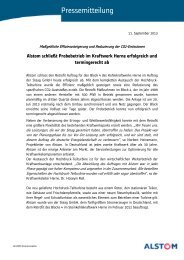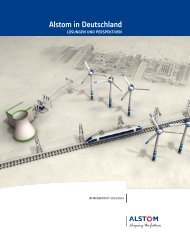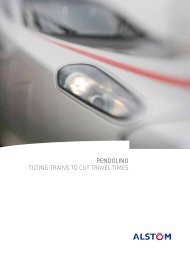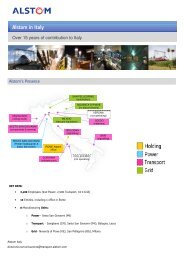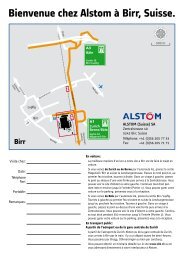MOROCCO IS ACCELERATING! feature - Alstom
MOROCCO IS ACCELERATING! feature - Alstom
MOROCCO IS ACCELERATING! feature - Alstom
Create successful ePaper yourself
Turn your PDF publications into a flip-book with our unique Google optimized e-Paper software.
38<br />
technology<br />
Coradia Duplex new generation in Valenciennes, in France.<br />
The origins of a concept…<br />
Everything began in the United States<br />
with the famous double-decker diligence.<br />
Then, in 1870, the concept was used for<br />
the fi rst time on rail. Strange double-decker<br />
cars began to be seen on American railway<br />
lines. An additional incongruity was<br />
that they had the appearance of a cabriolet:<br />
a conventional passenger ‘container’<br />
for the lower level, and an area open<br />
to the elements for the upper level.<br />
The idea was to enable passengers to admire<br />
the beauties of the American landscape.<br />
Half a century later and on the opposite<br />
side of the Atlantic, the concept resurfaces<br />
in Germany and in France… without<br />
the cabriolet option because of less<br />
favourable climates. Dedicated to suburban<br />
transport in France and to regional services<br />
in Germany, the double-decker was met<br />
with a degree of success, until the outbreak<br />
of the Second World War. This was followed<br />
by another gap, this time of twenty years,<br />
then by a marked recovery, in the late 1960s,<br />
in response to the growing demographic<br />
pressure of the Ile-de-France Region.<br />
The Nord-Pas-de-Calais, with its heavily<br />
populated urban areas, rapidly followed suit.<br />
The real technological breakthrough<br />
occurred, however, in the early 1980s with<br />
the ‘invention’ of the double-decker electric<br />
railcar. The idea was both simple and<br />
revolutionary: to combine strength<br />
– particularly for acceleration – with high<br />
capacity. Considered by many experts<br />
at the time as a fanciful technological dream,<br />
the project nevertheless saw the light of<br />
day thanks to the perseverance of engineers<br />
at the SNCF and the CIMT – Compagnie<br />
industrielle de matériel de transport –<br />
an industrial and engineering entity that




